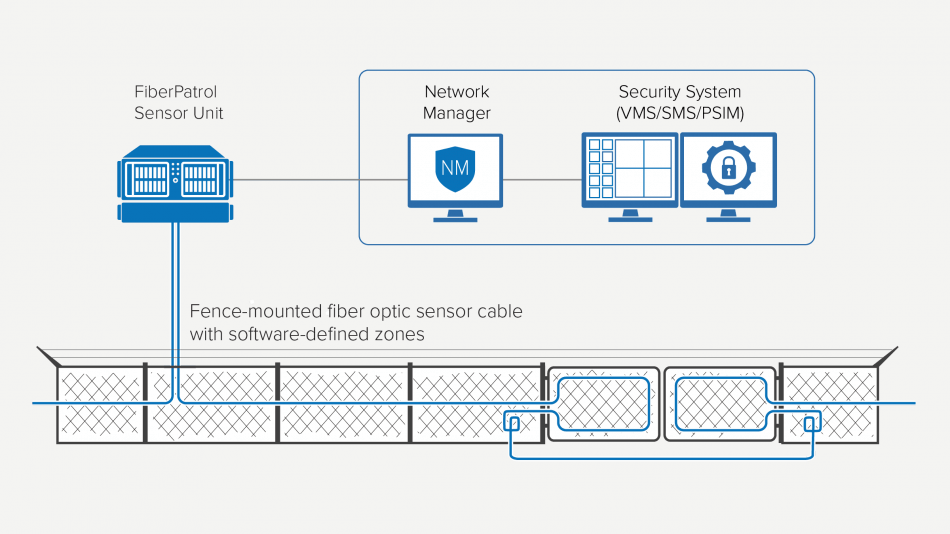Boost Your Safety With Advanced Fiber Optic Protection Solutions
In an age where safety is paramount, innovative fiber optic safety and security systems present an engaging solution for enhancing safety and security throughout various settings. What ramifications do these advancements hold for future safety actions?
Benefits of Fiber Optic Security
Using the advantages of fiber optic innovation considerably improves protection systems across numerous applications. Among the key benefits is the raised data transfer capacity, permitting the transmission of large quantities of information at high rates. This is especially vital for real-time video clip security, where high-resolution feeds can be sent out without latency, making sure prompt reaction abilities.
In addition, optical fiber show premium resistance to electro-magnetic interference, which is vital in atmospheres with prospective signal interruptions. This reliability ensures regular performance in vital safety operations. Fiber optic cable televisions are much less prone to tapping and unapproved gain access to compared to standard copper electrical wiring, thus enhancing data honesty and discretion.
An additional significant benefit is the longevity of fiber optic systems; they are a lot more immune to environmental aspects such as dampness, temperature level changes, and harsh compounds. This strength translates to reduce upkeep costs and longer life-spans for protection installations.
Last but not least, the light-weight nature of fiber optic cables assists in easier installment and routing, specifically in intricate facilities (fiber optic security system). Eventually, the integration of fiber optic technology into safety systems not just reinforces protection steps however likewise maximizes operational performance
Key Features to Take Into Consideration
When examining fiber optic safety and security systems, several essential features need to be thought about to guarantee ideal performance and performance. Initially, examine the system's discovery array and level of sensitivity; a comprehensive range permits keeping an eye on large locations, while high level of sensitivity makes certain that even minor disruptions are discovered quickly.
Following, take into consideration the integration capabilities of the system. A fiber optic safety system need to flawlessly user interface with existing security procedures such as cams and alarms, developing a cohesive safety and security network.
Sturdiness and environmental resistance are additionally vital functions. Guarantee that the system is designed to withstand rough weather and possible physical threats, as this will certainly lengthen its operational lifespan.

Finally, explore the scalability of the system. A robust fiber optic safety system ought to be easily expanding to accommodate future requirements without significant overhauls. By carefully considering these attributes, you can select a fiber optic safety remedy that enhances security and security in your atmosphere.
Setup Process Overview
To effectively apply a fiber optic safety system, a systematic setup procedure is crucial. This procedure starts with a comprehensive site assessment to figure out the particular safety requirements and to determine ideal places for fiber optic cords and security devices. Following this evaluation, the installment team will create a comprehensive strategy, consisting of cable paths, needed equipment, and conformity with local guidelines.
Next, the installment involves laying the fiber optic cords, guaranteeing they are shielded from ecological variables and physical damage. Correct have a peek here handling techniques are important, as fiber optic cable televisions are delicate and can be conveniently damaged. After the cabling is mounted, ports and terminations are meticulously finished to ensure signal stability.
The succeeding stage is composed of mounting safety gadgets such as electronic cameras, movement detectors, and alarm systems, all integrated with the fiber optic network. Rigorous screening is conducted to validate that all parts are operating appropriately and to make sure optimal performance.

Contrasting Fiber Optic to Conventional Equipments
The advancement of safety and security modern technology has resulted in significant advancements in the look here contrast in between fiber optic systems and typical copper-based systems. Fiber optic systems use light to send information, using remarkable transmission capacity and speed contrasted to their copper equivalents. This results in enhanced data transmission capabilities, making optical fiber ideal for high-resolution video clip security and real-time monitoring.
Furthermore, fiber optic wires are immune to electromagnetic disturbance, minimizing the likelihood of signal degradation created by exterior variables. This particular ensures consistent performance, even in difficult atmospheres. On the other hand, typical copper systems are a lot more at risk to disturbance, bring about possible vulnerabilities in security applications.
Longevity is an additional benefit of fiber optic systems. They are less susceptible to damage from ecological aspects such as moisture and temperature fluctuations, which can jeopardize copper wiring. In addition, optical fiber are lighter and thinner, allowing for easier installation and minimized physical impact.
Nevertheless, conventional systems have a tendency to have reduced preliminary expenses, making them attractive for budget-conscious projects. While fiber optic systems may need a greater in advance financial investment, their lasting advantages-- such as reduced upkeep expenses and better reliability-- usually exceed the first expense, placing them as a premium option for contemporary safety and security requirements.
Future Patterns in Safety Innovation
Emerging trends in protection technology are positioned to change the landscape of surveillance and hazard detection - fiber optic security system. As organizations significantly encounter innovative pop over to this web-site threats, advancements such as synthetic knowledge (AI) and device understanding (ML) are becoming indispensable to safety and security systems. These innovations improve the ability of fiber optic systems by enabling real-time information analysis, identifying anomalies, and automating actions to potential violations
Furthermore, the combination of the Web of Points (IoT) is reinventing protection frameworks. IoT tools can give detailed situational awareness and facilitate smooth interaction in between various protection components. This interconnectedness enables extra efficient surveillance and faster event reaction times.
Biometric verification is likewise obtaining energy, supplying a greater level of protection through distinct physical qualities. As this modern technology advances, it is likely to be included into fiber optic systems for improved accessibility control.
Final Thought
In final thought, progressed fiber optic safety and security systems stand for a significant development in safety and surveillance modern technology. The transition from standard systems to fiber optic options reflects an expanding fad in the direction of extra efficient and reliable protection procedures in a progressively complicated technological landscape.
 Ralph Macchio Then & Now!
Ralph Macchio Then & Now! Taran Noah Smith Then & Now!
Taran Noah Smith Then & Now! Hallie Eisenberg Then & Now!
Hallie Eisenberg Then & Now! Tahj Mowry Then & Now!
Tahj Mowry Then & Now! Jaclyn Smith Then & Now!
Jaclyn Smith Then & Now!